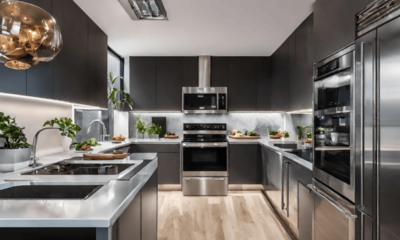Business
The Ultimate Custom Tradeshow Exhibit Guide
Published
1 year agoon
By
James flick
In a world where digital interactions dominate, the tangible experience of a tradeshow exhibit stands out as a unique opportunity. Your booth isn’t just a space; it’s a strategic tool for engaging potential clients and partners. ‘The Ultimate Custom Tradeshow Exhibit Guide’ walks you through setting clear objectives, selecting the right materials, and even mastering lighting techniques. But do you know the secret to transforming casual visitors into loyal customers? This guide’s insights on interactive elements and staff training tips will equip you with the knowledge needed to captivate and convert your audience effectively.
Setting Clear Objectives
Defining your goals is crucial to maximizing the impact and success of your custom tradeshow exhibit. You can’t afford to approach a tradeshow without a clear roadmap. Start by setting well-defined objectives that align with your broader business aims. Effective goal setting and strategy planning are essential to ensure your exhibit resonates with your target audience and delivers your messaging with clarity.
First, identify what you hope to achieve. Are you looking to generate leads, boost brand awareness, or launch a new product? Each goal requires a different approach. By pinpointing your objectives, you can tailor your strategy to meet these specific needs. For instance, if lead generation is your primary goal, focus on interactive elements that capture visitor information.
Next, understand your target audience. Who are they, and what do they care about? Knowing this allows you to craft messages that speak directly to their needs and interests. Your messaging clarity will make the difference between a visitor stopping by or walking past your booth.
Designing Your Booth
Crafting an eye-catching booth design is essential to attract visitors and effectively communicate your brand’s message. Start by leveraging color psychology to evoke specific emotions and behaviors. For instance, blue can instill trust, while red can create a sense of urgency. Choose colors that align with your brand messaging and make your booth stand out in a sea of competitors.
Your spatial layout should guide attendees naturally through your space. Strategically place key elements like product displays, interactive zones, and meeting areas to maximize engagement. Ensure there’s enough room for visitors to move comfortably, but also create focal points that draw them deeper into your booth.
Graphic design is your silent salesperson. High-quality, professional visuals should convey your brand’s essence and value proposition at a glance. Use banners, posters, and digital screens to display compelling graphics and concise, impactful messages. Remember, your booth is a three-dimensional representation of your brand.
Integrate your brand messaging seamlessly into every aspect of your booth design. From the colors and graphics to the spatial layout, each element should work together to tell a cohesive story. By doing so, you’ll create a memorable experience that resonates with your audience long after the tradeshow ends.
Choosing the Right Materials
Selecting the right materials for your tradeshow exhibit is crucial to ensuring durability, aesthetic appeal, and overall functionality. You want your booth to withstand multiple events, all while looking fresh and engaging.
Material durability should be your top priority. Choose robust, high-quality materials that can endure the wear and tear of transportation and setup. However, be mindful of budget constraints. It’s possible to achieve a balance between cost and quality by carefully selecting where to invest more and where to save.
Think about sustainable options. Not only do they offer a positive environmental impact, but they also resonate well with eco-conscious attendees. Materials like bamboo, recycled aluminum, and biodegradable textiles can enhance your booth’s visual impact while aligning with modern sustainability trends.
Remember, a visually compelling booth can attract more visitors and leave a lasting impression.
Consider the functionality of the materials. Lightweight, modular components are easier to transport and assemble, saving you time and labor costs. Don’t forget about aesthetics. High-gloss finishes, vibrant graphics, and textured surfaces can elevate your exhibit’s overall look.
Incorporating Technology
Integrating cutting-edge technology into your tradeshow exhibit can captivate your audience and set you apart from the competition.
Virtual reality experiences and augmented reality displays are two powerful tools that can transform your booth into an immersive environment. Imagine attendees stepping into a virtual world where they can interact with your products or services firsthand. This not only grabs attention but also creates memorable experiences.
Interactive touchscreens are another essential technology to consider. These can be used to display product information, videos, or even games, allowing visitors to engage with your brand in a dynamic way. Touchscreens can also streamline data collection, making it easier for you to follow up with leads.
Social media integration shouldn’t be overlooked either. Encourage attendees to share their experiences at your booth using branded hashtags, and display live social media feeds to generate buzz and engagement. This not only extends your reach but also creates a sense of community around your brand.
Effective Lighting Strategies
While advanced technology can draw visitors in, effective lighting strategies are what truly highlight your exhibit and make it unforgettable. To captivate your audience, focus on color temperature and placement. Warm tones (2700K-3000K) create a welcoming atmosphere, while cooler tones (4000K-5000K) can emphasize modernity and innovation.
Strategically place lights to draw attention to key elements of your display—consider using spotlights to highlight your main products or services.
Dimming options offer flexibility, allowing you to adapt the lighting to different times of day or the mood you want to create. Use dimmable LED lights to adjust the intensity and create dynamic environments that keep visitors engaged.
Highlighting specific areas with brighter lights can guide visitors’ attention and make your most important features stand out.
Interactive Elements
Elevate your tradeshow exhibit by incorporating interactive elements that engage visitors and create memorable experiences. Start with virtual reality experiences that transport attendees to another world, offering immersive product demonstrations that are both captivating and educational. VR setups can highlight complex features of your product in a way that static displays simply can’t match.
Leverage social media engagement to extend the reach of your exhibit. Encourage visitors to share their experiences online using a unique hashtag, and set up live feeds or social walls to display these posts in real-time. This not only builds buzz around your booth but also creates a sense of community among attendees.
Gamification techniques can turn your exhibit into an exciting challenge. Develop interactive games related to your product or service, offering rewards or incentives for participation. This not only draws visitors in but also ensures they spend more time at your booth, increasing the likelihood of meaningful interactions.
Staff Training Tips
Ensuring your tradeshow staff are thoroughly trained will dramatically boost the effectiveness of your exhibit and leave a lasting impression on attendees. Start by incorporating role playing exercises into your training regimen. These exercises simulate real-world interactions, allowing your team to practice and refine their communication techniques. Effective communication is key to making every interaction count.
Scenario based training is another powerful tool. By creating various customer engagement scenarios, you can prepare your staff for a range of situations they might face. This strategic approach helps them think on their feet and respond confidently to questions or concerns. For instance, simulate a scenario where a potential client asks about a product feature. Your staff should be equipped to provide clear, concise, and persuasive answers.
Don’t overlook the importance of body language and active listening. Train your team to maintain eye contact, use open gestures, and listen attentively. This not only fosters trust but also makes visitors feel valued.
Measuring Success
Once your staff is expertly trained, the next step is to measure the success of your tradeshow exhibit with strategic and data-driven methods. Start with ROI analysis to assess the financial impact. Compare the costs of your exhibit against the value of the leads and sales generated. This analysis will provide a clear picture of whether your investment is yielding profitable returns.
Focus on attendee engagement metrics as well. Track how many visitors interacted with your exhibit, attended presentations, or participated in demos. High engagement rates often translate to higher lead quality. Use digital tools to capture these interactions and analyze the data for insights.
Lead generation is another critical metric. Measure the quantity and quality of leads collected. Ensure your team inputs data accurately and follows a standardized process. The more precise your lead data, the better your post-show follow-up will be.
Conclusion
You’ve crafted an exhibit that’s both stunning and strategic, but don’t forget, the devil’s in the details. As you stand ready to captivate your audience or risk blending into the crowd, remember that your lighting can either spotlight your success or cast shadows over your efforts.
With the right materials and tech, you’re not just building a booth; you’re creating an experience. Execute flawlessly, and watch your ROI soar as competitors fade into the background.


